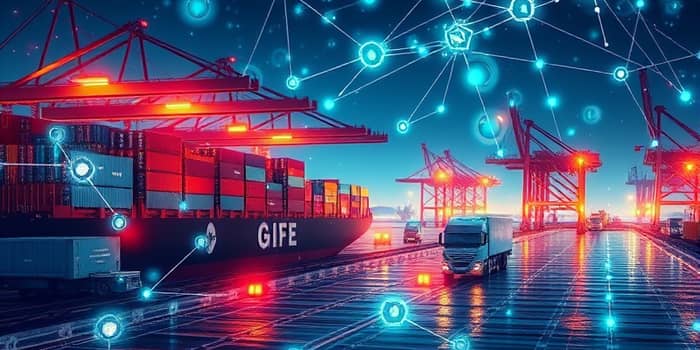
In a rapidly evolving global economy, supply chains have become intricate webs of manufacturers, distributors, and retailers spanning continents. Today, blockchain technology is emerging as a cornerstone for enhanced traceability and accountability. Companies are embracing decentralized ledgers to foster transparency, reduce costs, and comply with stringent regulations. This article explores how blockchain is transforming every link in the supply chain, providing essential insights and practical strategies for businesses ready to harness this innovation.
The numbers alone paint a compelling picture of blockchain’s explosive growth in logistics. In 2025, the worldwide blockchain supply chain market was valued at $3.27 billion. Industry analysts project this figure will soar to $21.29 billion by 2029, driven by a remarkable compound annual growth rate (CAGR) of 59.8%. Sustainable supply chain solutions, a segment garnering particular attention, were valued at $827.6 million in 2024 and are expected to expand at a steady 35.1% CAGR through 2034.
This financial backdrop underscores the urgency for supply chain leaders to evaluate blockchain as a strategic investment. With transaction costs projected to drop by up to 35% and productivity gains of 30% through robotics and automation, early adopters stand to gain significant competitive advantages in efficiency. Whether you are in healthcare, automotive, or cold chain logistics, these projections signal an inflection point in operational excellence.
Several powerful forces are propelling blockchain integration across logistics networks. First, the unparalleled growth of e-commerce has magnified demands for supply chain agility. Global e-commerce sales topped $5.8 trillion in 2023, creating pressure on traditional systems to deliver faster, error-free shipments.
Second, increasing regulatory requirements for sustainability and ethical sourcing have intensified the need for immutable audit trails. The EU Directive on Corporate Sustainability Due Diligence, among other regulations, is pushing companies to adopt technologies that ensure full lifecycle visibility of products. Third, the persistent threat of counterfeit goods and fraud underscores the importance of tamper-evident records, a hallmark of blockchain’s decentralized ledger.
Blockchain’s prowess extends far beyond simple record-keeping. At its core, the technology provides a secure, immutable ledger capable of interfacing with intelligent contracts, IoT sensors, and AI-driven analytics. Companies are leveraging it for a wide range of applications:
In the automotive sector, for instance, blockchain-powered digital twins enable predictive maintenance and lifecycle monitoring of individual components. Healthcare providers tap into decentralized ledgers to verify pharmaceutical provenance, safeguarding against counterfeit drugs. These innovations demonstrate how blockchain can bridge physical operations with digital assurance, paving the way for fully autonomous supply networks.
To illustrate the trajectory of blockchain adoption in supply chain logistics, the following table summarizes key forecast data. Understanding these benchmarks can help executives craft targeted strategies and budget effectively for technology investments.
*Estimated based on current CAGR trends for sustainable solutions.
Despite the clear benefits, widespread blockchain adoption faces real-world hurdles. Legacy systems reliant on spreadsheets and PDFs still dominate many supply chain processes. Moreover, the technical complexity of blockchain platforms can intimidate stakeholders unfamiliar with cryptographic principles and decentralized networks.
Successful implementation requires forging cross-industry partnerships. Logistics firms, technology vendors, and regulatory bodies must align goals to establish interoperable standards. Initiatives such as consortium-based blockchains and open-source protocols are already reducing barriers by fostering shared governance frameworks. Training programs and collaborative pilot projects can equip supply chain professionals with the skills needed to manage and optimize blockchain networks.
By committing to open collaboration with ecosystem partners, organizations can accelerate the transition from manual processes to integrated, real-time supply chain platforms. This cooperative mindset transforms blockchain from a niche experiment into a scalable, enterprise-grade solution.
The convergence of blockchain with artificial intelligence, robotics, and digital twin technologies represents the next frontier in supply chain innovation. AI-driven smart contracts will automate settlements, dynamically triggering payments when predefined conditions—such as delivery confirmations—are met. Robotics, expected to boost warehouse productivity by up to 30%, will be orchestrated via blockchain-based trust mechanisms, ensuring coordinated, secure operations.
Digital twins—virtual replicas of physical assets—linked to blockchain can provide comprehensive lifecycle insights. These digital models will integrate real-time sensor data and immutable event logs, enabling predictive maintenance, optimized routing, and adaptive inventory management. The result is an autonomous supply network that learns and evolves with each transaction, delivering efficiencies previously unattainable.
As blockchain platforms mature, we can anticipate advanced security features such as zero-knowledge proofs and decentralized identities. These innovations will bolster confidentiality, allowing selective data sharing without sacrificing transparency. Ultimately, this technological synergy will empower organizations to craft supply chains that are resilient, sustainable, and ethically aligned with global standards.
Blockchain has transcended its cryptocurrency origins to become a transformative force in supply chain logistics. From transparent provenance tracking to automated compliance and revolutionary AI integration, the technology unlocks unprecedented value at every stage of the supply chain. The coming years will witness radical improvements in cost efficiency, risk mitigation, and operational agility.
For supply chain leaders, the imperative is clear: adopt a proactive stance on blockchain experimentation, invest in cross-industry collaboration, and build the technical expertise required to leverage decentralized systems. The future belongs to organizations that embrace digital innovation and champion end-to-end supply chain transparency. By doing so, they will deliver superior service, respond swiftly to disruptions, and contribute to a more sustainable global economy.
References













